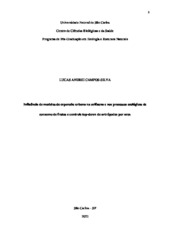Influência de modelos de expansão urbana na avifauna e nos processos ecológicos de consumo de frutos e controle top-down de artrópodes por aves
Abstract
Cityscapes are growing fast and heterogeneously through of diverse urban sprawl models. Urban sprawl models are defined as the specific patterns of the urban spaces’ growth. Since each model performs unique physical and social landscape changes, this needs to be evaluated in urban planning, aiming balance the urban development and biological conservation. The main objective of the thesis was to understand how compacted (i.e., land-sparing) and sprawled (i.e., land-sharing) urban sprawl models affect the urban landscape, and how, consequently, influence its biodiversity, and in turn their ecological functions. For this we used the birds as the biological model. In the first chapter was evaluated how these urban sprawl models affect the sizes of the green and gray spaces along an urbanization gradient, and how, consequently, they affect birds’ diversity in a conurbation area existing between two cities (i.e., Sorocaba and Votorantim) in Brazil. The results show that there is a difference in the sizes of the green and gray spaces between the urban sprawl models, with larger green spaces in the compacted model, and higher birds’ diversity in the compacted model. This result can support strategies aimed at the conservation of larger green spaces, since a positive relationship was detected between both native forests, trees and birds’ diversity. In addition, this result can support the urban growth leaded to the compacted model instead of spread, since higher birds’ functional diversity was registered in the first model. The second chapter aims to understand how these urban sprawl models affect the frugivorous birds’ diversity and also the fruit consumption by birds. The results show that (1) there are higher frugivorous birds’ functional diversity in the compacted model instead of the sprawled, (2) there is a positive relationship between frugivorous birds’ functional diversity and the size of green spaces, and there is (3) a positive relationship between frugivorous birds’ functional diversity and fruit consumption by birds. These results can support strategies leading the cities growth for the compacted model instead of sprawled, since higher frugivorous birds’ functional diversity was detected, and also in conservation actions aimed at conserving of larger urban green spaces. Fruit consumption is related to ecological processes, e.g., seed dispersal and the structure of plants-frugivores networks dynamics, which consequently affect the plants’ distribution and population. Therefore, these results can also help in the well-being of the people who live in the cities, since plants perform ecosystem services. The third chapter aims to understand how these urban sprawl models affect the insectivorous birds’ diversity and their ecological function related to the top-down control of arthropods. The results show that (1) there is higher insectivorous birds’ functional diversity in the compacted model than in the sprawled, (2) there is a positive relationship between insectivorous birds’ functional diversity and green spaces’ size, and also that there is (3) a positive relationship between insectivorous birds’ functional diversity and top-down control of arthropods. These results can support strategies aimed at cities growth related to the compacted model instead of spread, since greater insectivorous birds’ functional diversity was detected, and also in conservation efforts leaded in larger urban green spaces. The top-down control of arthropods by birds is related to the maintenance of the bird-arthropod dynamics’ structure, a factor that consequently, affects the arthropods’ distribution and population. Arthropods perform many ecosystem services and disservices along the urban landscape. Therefore, these results can influence the insectivorous birds’ conservation, and also the well-being of the people who live in the cityscapes.
Collections
The following license files are associated with this item:

